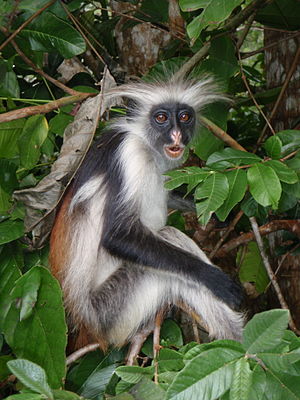Zanzibar colobus monkey
| Zanzibar colobus monkey | ||||||||||||
|---|---|---|---|---|---|---|---|---|---|---|---|---|

Zanzibar colobus monkey ( Piliocolobus kirkii ) |
||||||||||||
| Systematics | ||||||||||||
|
||||||||||||
| Scientific name | ||||||||||||
| Piliocolobus kirkii | ||||||||||||
| ( Gray , 1868) |
The Zanzibar colobus monkey ( Piliocolobus kirkii ) is a primate species from the group of colobus monkeys within the family of the vervet monkeys (Cercopithecidae).
description
The animals have a black or dark red fur on the back. The fur is black along the shoulders and arms . The black, hairless face with red-brown eyes is framed by a white crown of hair. The mouth and nose are pigmented pink. The belly of the monkeys is white or reddish yellow to gray. Zanzibar colobus monkeys reach a head body length of 45 to 65 centimeters, to which a 58 to 77 centimeter long tail comes. The weight varies between 5.2 and 11.3 kilograms, with the females mostly being smaller than the males.
distribution and habitat
The species is endemic to the Zanzibar archipelago . Most of the animals live on the main island of Unguja, some introduced individuals also live on Pemba . Their habitat are forests, in addition to primary forests they can also be found in secondary forests . The entire distribution area on Unguja is given with an area of 376 km². The population density is 17 individuals per square kilometer.
Lifestyle and diet
The Zanzibar colobus monkey is a diurnal tree dweller. He lives together in larger groups of 3 to 52 animals. A field study between 2013 and 2015 showed an average group size of 17 animals, with those in protected areas with an average of 20 animals being larger than those outside, where they are made up of around 12 individuals. Several males and around two to three times as many females live in a group, which roughly corresponds to the sex ratio (1: 3.3). The animals can reproduce all year round. In the first few months the young animals have a black back. They are suckled for up to 17 months.
The animals feed mainly on unripe fruits , leaves , flowers and seeds . Ripe fruits are avoided as these monkeys cannot digest sugar. To digest toxic substances, they eat coal, which they even fetch from fireplaces.
Danger
The Eastern red colobus is in the red list of the IUCN (as "critically endangered" endangered ) out. The reasons for this lie in the destruction of the habitat and hunting. The total population was estimated to be 1,000 to 15,200 animals in the 1990s, later to fewer than 2,000 individuals. A census between 2013 and 2015, on the other hand, assumes a total of more than 5860 animals, which are distributed over 340 groups. More than 4000 of them live in protected areas. The most important sanctuary of the species is the Jozani Chwaka Bay National Park , which is home to nearly 3,000 individuals.
literature
- Thomas Geissmann : Comparative Primatology. Springer-Verlag, Berlin et al. 2003, ISBN 3-540-43645-6 .
- Don E. Wilson, DeeAnn M. Reeder (Eds.): Mammal Species of the World. A taxonomic and geographic Reference. Johns Hopkins University Press, Baltimore MD 2005, ISBN 0-8018-8221-4 .
Individual evidence
- ↑ a b c Tim RB Davenport, Said A. Fakih, Sylvanos P. Kimiti and Lydia U. Kleine: Zanzibar's endemic red colobus Piliocolobus kirkii: first systematic and total assessment of population, demography and distribution. Oryx 53 (1), 2019, pp. 36-44.
- ↑ Sansibar Colobus ( Memento from November 27, 2005 in the Internet Archive ) on br-online.de.
- ↑ Piliocolobus kirkii in the Red List of Threatened Species of the IUCN 2009. Posted by: T. Struhsaker, K. SIEX, 2008. Accessed on 5 November of 2009.
Web links
- Information and pictures on arkive.org
- Information on primatis.de
